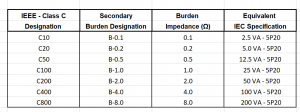Equivalence of IEEE and IEC Specifications
We are now in a position to establish the equivalence between the IEEE and IEC specifications. The first step is to calculate the IEC rated output in VA using the IEEE class designation and the rated burden. (Refer to the CT Specs – Part 1 for details of calculating the rated output in VA.) The results are as shown in Table 3.
Table 3 – IEEE to IEC Equivalence for 5 A Current Transformers

Note that equivalent IEC accuracy is shown as 5P20 and not 10P20. IEEE C57.13 specifies the power factor for rated burden as 0.5 (Cos 60º). This was required in the case of electromagnetic relays where the burden is inductive. The IEC standard specifies purely resistive burden, which is more relevant for modern microprocessor-based relays. This quirk in the burden specification makes the accuracy specification of 10% at 20 times the rated current in the IEEE standard equivalent to the IEC specification of 5P20.
Concluding Remarks
One of the features of IEEE standards is that they are technically oriented documents. Some of the IEEE standards are almost like engineering textbooks. They are good technical reference documents which can be used by an engineer anywhere in the world. IEEE standards are technical documents, since legalistic aspects of the standard are covered by corresponding American National Standard Institution (ANSI) documents.
The IEEE specifications are generally more standardised with limited options. For example, only the CT rated outputs (CT designations) listed in Table 3 can be specified. This helps to simplify site standards and to reduce site issues. In contrast, IEC standards are designed for flexibility, so as to cater for the requirements of various participating countries.
I am in two minds about IEC specification of rated output for current transformers. The specification of VA rating for electrical equipment appears to be logical. But there is a problem in the case of current transformers. For example, a CT specification of 30 VA, 5P10 is the same as specifying 15 VA, 5P20. In fact, one can specify several such combinations to meet the required CT performance!
Which is the better CT specification – IEEE or IEC? You be the judge!!

Thanks for providing this service. Very much appreciate.
My pleasure! More to come!
Regards – Sesha